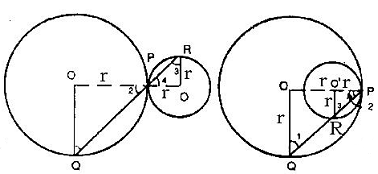Two circles C(O, r) and C1(O1, r1) touch each other at P, externally or internally.

Construction: join OP and O1P .
Proof : we know that if two circles touch
each other, the point of contact lies on the line through the centres.
O, P,O1 are collinear
OPO1 is a sttraight line.
Case I: C(o,r) and C1(o1,r1 )touch externally at P.
In ΔOPQ, OP=OQ= r
∠OQP =∠OQP (Angle opposite to equal sides)
Similarly in ΔO1PR, O|P= O|R=r|
∠ORP = ∠RPO -------(2)
Also ∠OPQ = ∠RPO -------(3) (Vertically opposite angles)
From (1),(2) and(3) we get
∠OQP = ∠RPO
But these are alternate angles
=> OP u O1R
Case I I: C(o,r) and C(o1,r1) touch internally at P .
In ΔOPQ, OP=OQ= r
∠OQR = ∠O|RP ...................(4) (angles opposite to equal side)
Similirarly in ΔO|PR, O|P = O|R =r|
∠ORP = ∠O1PR ...................(5)
From (4) and (5) we get ∠OQR = ∠O|RP
But these are correspondingg angles.
OQ // O|R